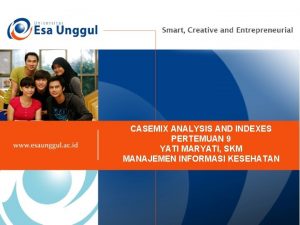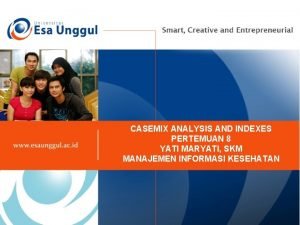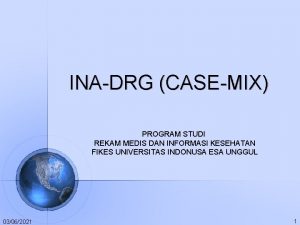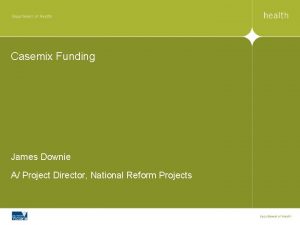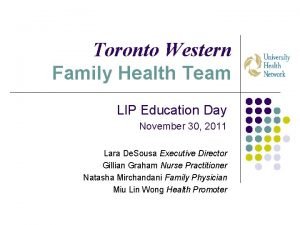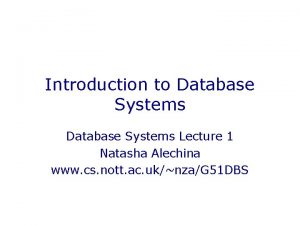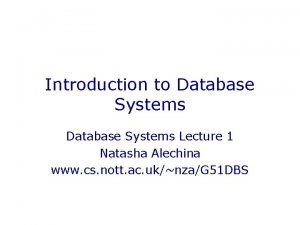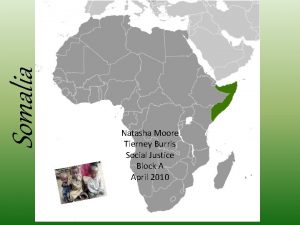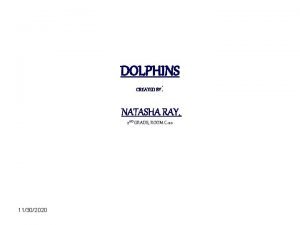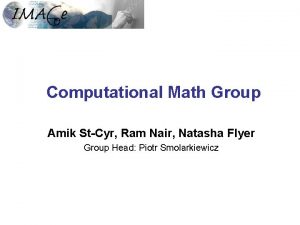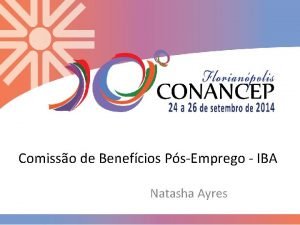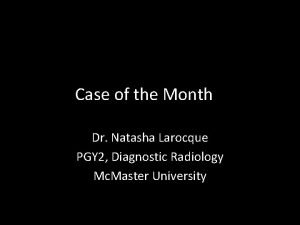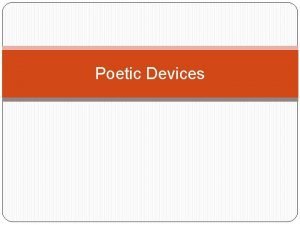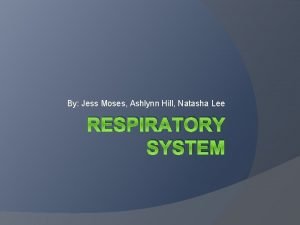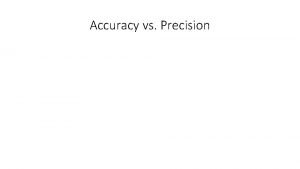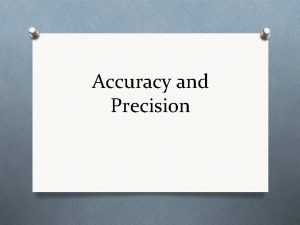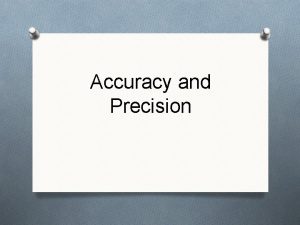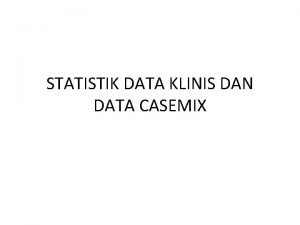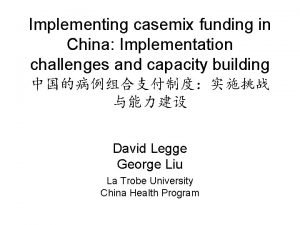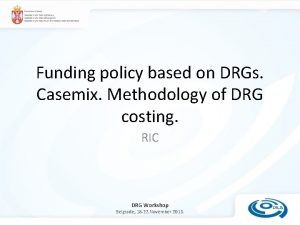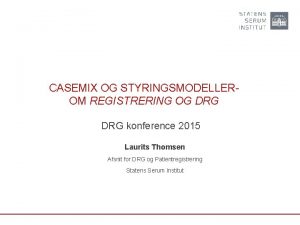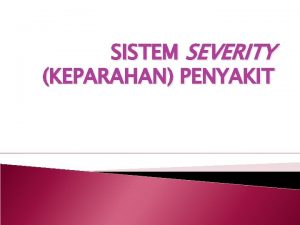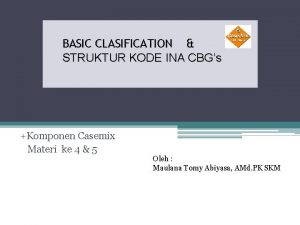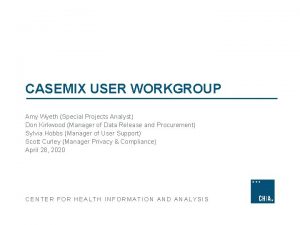INTRODUCTION TO CASEMIX Accuracy is the key Natasha




















































- Slides: 52

INTRODUCTION TO CASEMIX Accuracy is the key Natasha Smith Clinical Coding and Casemix Manager Natasha. Smith@swahs. health. nsw. gov. au 1

Topics to be covered w Introduction to Casemix w DRGs w Clinical Coding & Documentation w Service Categories 2

Introduction to Casemix w Casemix systems are information tools used to classify episodes of patient care. w Used to help understand manage health care. w Helps to classify services provided by hospitals. 3

Casemix Classification systems w Classification systems have been developed for the following types of care l l l Outpatient Services (Clinic types) Emergency Services (UDAG’s) Acute Inpatient Care (DRG’s) Intensive Care Services (Beddays) Mental Health Rehabilitation and Extended Care (AN-SNAP) 4

What is a Diagnosis Related Group (DRG)? w Classify an inpatient episode of care w DRGs represents a class of inpatients n similar clinical conditions n similar resource inputs w DRGs are allocated a cost weight w Current NSW version is V 6. X AR-DRG 5

Diagnosis Related Groups (DRGs) w For example: DRG E 65 – Chronic Obstructive Airways Disease Includes: n Bronchitis n Emphysema n COPD n Bronchiectasis 6

What does a DRG look like? ? w Alphanumeric Eg. E 65 A w E indicates the MDC the DRG falls into (Diseases and Disorders of the Respiratory System) w 65 indicates the DRG partition n 01 -39 indicates the surgical partition 40 -59 indicates the other partition 60 -99 indicates the medical partition w A indicates splits n n resource consumption, and acuity of the patient 7

DRGs – splits w E 65 – one split 8

DRGs – splits w F 74 – no splits 9

w J 64 – splits: n By age & complications w J 64 – split on age 10

w B 70 – splits: n By LOS / discharge destination & complications 11

What is a Cost Weight? w w Each DRG has a cost weight A measure of resource consumption Allow DRGs to be compared relative to each other NSW - AR-DRG V 6. 0 cost weights 0 E 65 B – COAD without Sev or Cat CC E 65 A – COAD with Sev or Cat CC Cost Weight: 1. 17 Cost Weight: 2. 17 Lower cost weight decreasingly complex 1 Higher cost weight increasingly complex 26 + 12

DRGs – cost weights Cost weight 0. 41 Cost weight 3. 02 Cost weight 1. 33 Cost weight 0. 69 13

DRGs as a $ value § The cost weight is multiplied by the peer percentile price 0 E 65 B – COAD without CC E 65 A – COAD with CC CW: 1. 17 x $4, 384 = $5129 CW: 2. 17 x $4, 384 = $9513 Lower cost weight decreasingly complex 1 Higher cost weight increasingly complex X NSW Average price: 1 = $4, 384 14

Topics to be covered w Introduction to Casemix w Uses of casemix information w Diagnosis Related Groups (DRGs) w Clinical coding & documentation – general overview w Service Categories 15

What is Clinical Coding Medical Record Documentation Clinical Coding DRG Assignment Clinicians document diagnoses and procedures in the medical record Documentation translated into alphanumeric ICD-10 -AM codes Codes/Age/Discharge status used to assign ARDRGs. Computer software used (Encoder) Cost Weights Assigned to each AR-DRG. Average value of treating a patient Funding Cost weights used in NSW Episode Funding Model to distribute funds to each AHS 16

The Clinical Coding process w General overview of coding process w Specialty based information – department follow up meetings w Request through Evaluation Forms or via direct contact (phone / email) 17

The Clinical Coding process w The Clinical Coder reviews the inpatient episode to identify the relevant diagnoses and procedures for the patient: n n n Registration form & Discharge summary RFA Emergency notes/Ambulance Forms Progress notes Obstetric forms Operative theatre forms Consults Care plans/clinical pathways Investigation reports Medication charts Flow charts 18

ICD-10 -AM Coding Standards w Bound by Australian Coding Standards (ACS) w For example, Clinical Coders are not permitted to interpret laboratory, x-ray, pathological and other diagnostic results which require interpretation by a clinician. 19

Good Clinical Documentation ACS 0001 – Principal Diagnosis w The final diagnosis following investigation responsible for the episode of care w To be documented on the Discharge Summary 20

Clinical Documentation – Principal Diagnosis: ICD-10 -AM Clinical Codes: ACS 0001 Principal Diagnosis 21

Clinical Documentation – Principal Diagnosis: w Clear diagnosis w Good documentation about factors affecting patient management

Good Clinical Documentation ACS 0002 – Additional diagnoses Conditions that affect patient management in terms of requiring any of the following: t Commencement, alteration or adjustment of therapeutic treatment t Diagnostic procedures t Increased clinical care and/or monitoring 23

Clinical Documentation – Additional diagnoses: w E. g. During admission patient develops UTI, and is treated with antibiotics. UTI would be coded as additional diagnosis, as it meets the additional diagnosis standard criteria (commencement of therapeutic treatment). ALTERNATIVELY w Patient presents with a stroke and also has a background history of having peptic ulcer disease (PUD) 5 years ago. PUD would not be coded, as it does not meet the additional diagnosis criteria. 24

Clinical Documentation – Diagnosis and Action: ICD-10 -AM Clinical Codes: ACS 0002 Additional Diagnosis – change in therapeutic treatment ACS 0401 Diabetes Mellitus 25

Good Clinical Documentation w Complications n E. g. wound infection, urinary retention, acute blood loss, post-operative problems, adverse effects of drugs, surgical complications. w Procedures n n Procedures performed in theatre Non-operative procedures such as allied health interventions, blood transfusion, biopsies, lumbar punctures, CTs, MRIs, cardiac catheterisation, etc. 26

Clinical Documentation – Complications / Adverse Effects: Link the symptom to a diagnosis, and document the action taken … 27

Symptom 28

Symptom Diagnosis 29

Cause 30

Cause Action 31

ICD-10 -AM Clinical Codes: ACS 0002 Additional Diagnosis - change in therapeutic treatment ACS 1902 Adverse Effects 32

Coder Benchmarks …. w Coding output benchmarks set per facility w Based on casemix of facility w Range from n n 4 records per hour (ie, 15 minutes per episode) to 6. 5 records per hour (ie, 9 minutes per episode) w Clearer documentation = clearer decision making for coders 33

Then what …. w The coded data is then grouped to determine the types of patients treated and the costs of providing care. w The coded data is grouped by an electronic grouper called the 3 M Encoder. w The Encoder groups the data into Diagnosis Related Groups (DRGs). 34

Effect of Documentation on DRGs Selection of Additional Diagnosis …… 35

Episode Details Principal Diagnosis: J 44. 0 COPD with exacerbation Additional Diagnosis: Nil Discharge Status: Discharge to Home Cost Weight Guide $ Value 1. 17 $5, 129 DRG E 65 B – Chronic Obstructive Airway Disease W/O Cat or Severe CC Ref: NSW Episode Funding Policy 11/12: PRC A 1 = $4, 384 36

Episode Details Principal Diagnosis: Hyperkalaemia Additional Diagnosis: Nil Discharge Status: Discharge to Home Cost Weight Guide $ Value 0. 62 $2718 DRG K 62 B Miscellaneous Metabolic Disorders Ref: NSW Episode Funding Policy 11/12: PRC A 1 = $4, 384 37

Episode Details Principal Diagnosis: J 44. 0 COPD with exacerbation Additional Diagnosis: E 11. 69 Diabetes Mellitus with other specified complications L 97 - Ulcer of lower limb Discharge Status: Discharge to Home Cost Weight Guide $ Value 2. 17 $9, 513 DRG E 65 A – Chronic Obstructive Airway Disease W Cat or Severe CC Ref: NSW Episode Funding Policy 11/12: PRC A 1 = $4, 384 38

Effect of Documentation on DRGs Selection of Principal Diagnosis ………… 39

Episode Details Presenting Problem: Chest Pain Principal Diagnosis: R 07. 4 Additional Diagnosis: Nil Chest Pain, unspecified Cost Weight Guide $ Value 0. 41 $1, 797 DRG F 74 Z – Chest Pain Ref: NSW Episode Funding Policy 11/12: PRC A 1 = $4, 384 40

Episode Details Presenting Problem: Chest Pain Principal Diagnosis: I 20. 0 Additional Diagnosis: Nil Unstable Angina, unspecified Cost Weight Guide $ Value 0. 60 $2630 DRG F 72 B – Unstable Angina W/O Catastrophic or Severe CC Ref: NSW Episode Funding Policy 11/12: PRC A 1 = $4, 384 41

Episode Details Presenting Problem: Chest Pain Principal Diagnosis: I 21. 9 Additional Diagnosis: Nil Acute Myocardial Infarction, unspec Cost Weight Guide $ Value 0. 93 $4077 DRG F 60 B – Circulatory Disorders W AMI W/O Invasive Cardiac Procedure W/O Cat or Sev CC Ref: NSW Episode Funding Policy 08/09: PRC A 1 = $4, 169 42

Episode Details Presenting Problem: Chest Pain Principal Diagnosis: I 21. 9 Additional Diagnosis: J 12. 9 – Viral Pneumonia, unspecified L 89. 0 – Stage 1 decubitus ulcer and pressure area Acute Myocardial Infarction, unspec Cost Weight Guide $ Value 2. 37 $10390 DRG F 60 A – Circulatory Disorders W AMI W/O Invasive Cardiac Procedure W Cat or Sev CC Ref: NSW Episode Funding Policy 11/12: PRC A 1 = $4, 384 43

Topics to be covered w Introduction to Casemix w Uses of casemix information w Diagnosis Related Groups (DRGs) w Clinical Coding & Documentation – general overview w Service Categories 44

Service Categories u u What is a service category? What is an episode of care? n An episode of care refers to a phase of treatment defined by the acuity of the patient 1 st episode of care eg, Acute 2 nd episode of care eg, Rehabilitation “Stay” in Hospital n There may be more than one episode of care within the one inpatient stay. 45

Service Categories u Types of service categories: 1. 2. 3. 4. Acute Rehabilitation Palliative Care Maintenance Care (non-acute) l Nursing Home l Respite l Convalescent 5. Newborn 7. Geriatric Evaluation and Management 8. Psychogeriatric 46

Service Categories u Does the patient require a service category change? n n Consult with your clinical team If the decision is made to change service category, make an appropriate notation in the notes The service category should start once the care for the new service category is being provided Advise the clerical staff member to make the change on the PAS 47

AMO Responsibilities w AMO (or Delegate) identifies a change in clinical intent and therefore a change in service category. The AMO (or delegate) completes a Service Category Change Notification sticker. w AMO (or delegate) then affixes sticker to progress notes and advises the ward clerk. 48

One Episode of Care ADMISSION 01/01/12 DISCHARGE 16/01/12 Stay LOS: 15 days Episode 1 (LOS: 15 days) Admit: Medical - Transfer Care: Rehab on day 8 Episode 1: (Principal Diagnosis – Stroke) DRG: B 70 C - $6, 312 Cost Weight: 1. 44 LOS: 7. 2 days Ref: NSW Episode Funding Policy 11/12: PRC A 1 = $4, 384 49

Multiple Episodes of Care ADMISSION 01/01/12 DISCHARGE 16/01/12 Stay LOS: 15 days Admit: Medical Episode 1: (PDx – Stroke) DRG: B 70 C - $6, 312 Cost Weight: 1. 44 LOS: 7. 2 days Service Category Change: 07 Jan 2009 Episode 1 (LOS: 7 days) Episode 2 (LOS: 8 days) Transfer Care: Rehab on day 8 Episode 2: (PDx – Rehab) DRG: Z 60 A SNAP class: 2204 Cost weights: Episode, Outlier per diem, Inlier per diem Ref: NSW Episode Funding Policy 11/12: PRC A 1 = $4, 384 50

Coder-Clinician program Aims: w w w w Improve clinical documentation Review Health Round table data Review specific cases on request Review recent discharges Seek clinical advice on diagnosis Provide education to coders Maintain coder-clinician relationships 51

Questions 52
 Universal grouper adalah
Universal grouper adalah Komponen casemix
Komponen casemix Komponen casemix
Komponen casemix Casemix rekam medis
Casemix rekam medis Casemix funding
Casemix funding Complaints were made by teachers and administrators also
Complaints were made by teachers and administrators also Fht twh
Fht twh Natasha hutson
Natasha hutson Natasha weaver
Natasha weaver Natasha duffy
Natasha duffy Natasha alechina
Natasha alechina Natasha alechina
Natasha alechina Natasha tierney
Natasha tierney Natasha bowler
Natasha bowler Natasha milashevich
Natasha milashevich Dr natasha shetty
Dr natasha shetty Dolphin ray tracing
Dolphin ray tracing Natasha webb prather
Natasha webb prather Natasha whiteman
Natasha whiteman Estudo ecologico
Estudo ecologico Mesoamerican reef facts
Mesoamerican reef facts Natasha werpy
Natasha werpy Natasha st cyr
Natasha st cyr Natasha ayres
Natasha ayres Mosaic attenuation radiopaedia
Mosaic attenuation radiopaedia Poetic devices
Poetic devices Natasha tracy
Natasha tracy Natasha gerolami
Natasha gerolami Natasha sharygina
Natasha sharygina Natasha lee muscle
Natasha lee muscle Natasha jankowski
Natasha jankowski Key partners business model canvas
Key partners business model canvas Key partners
Key partners Hình ảnh bộ gõ cơ thể búng tay
Hình ảnh bộ gõ cơ thể búng tay Frameset trong html5
Frameset trong html5 Bổ thể
Bổ thể Tỉ lệ cơ thể trẻ em
Tỉ lệ cơ thể trẻ em Chó sói
Chó sói Tư thế worms-breton
Tư thế worms-breton Hát lên người ơi alleluia
Hát lên người ơi alleluia Môn thể thao bắt đầu bằng từ đua
Môn thể thao bắt đầu bằng từ đua Thế nào là hệ số cao nhất
Thế nào là hệ số cao nhất Các châu lục và đại dương trên thế giới
Các châu lục và đại dương trên thế giới Công của trọng lực
Công của trọng lực Trời xanh đây là của chúng ta thể thơ
Trời xanh đây là của chúng ta thể thơ Mật thư anh em như thể tay chân
Mật thư anh em như thể tay chân 101012 bằng
101012 bằng độ dài liên kết
độ dài liên kết Các châu lục và đại dương trên thế giới
Các châu lục và đại dương trên thế giới Thể thơ truyền thống
Thể thơ truyền thống Quá trình desamine hóa có thể tạo ra
Quá trình desamine hóa có thể tạo ra Một số thể thơ truyền thống
Một số thể thơ truyền thống Cái miệng nó xinh thế chỉ nói điều hay thôi
Cái miệng nó xinh thế chỉ nói điều hay thôi

